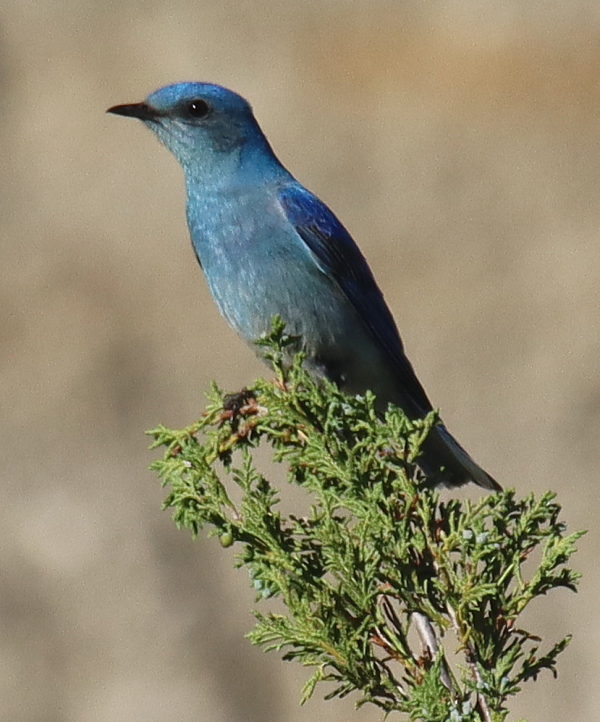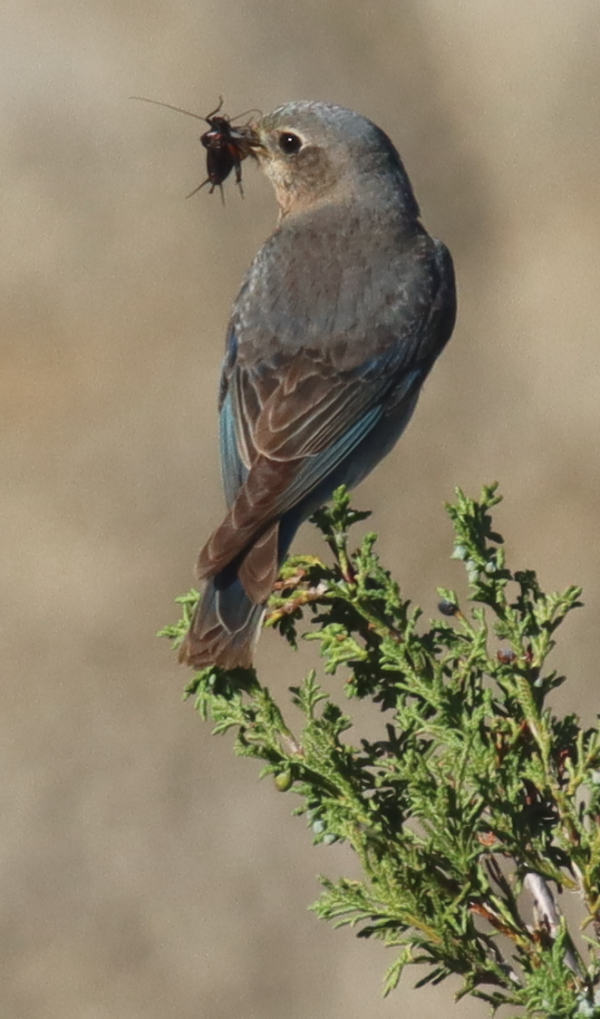
The best treat was to photograph the male Mountain Bluebird as it gingerly landed on the juniper top, with its wings extended over its back to provide the appearance of action (all photos taken at f7, 1/2000, ISO 400).
|
I’ve been in a travel mode recently, heading east to the forest and lake country of Minnesota a week ago on a loon photo mission. Then, appreciating that the green season was at its peak, I wanted to take advantage of the rewards of spring rains in the drier country to the west, in the infamous Badlands. When I shared with a friend that I was headed for the Badlands, a favorite outdoor destination in western North Dakota, she asked me what I hoped to photograph? I responded: “Mountain Bluebirds, Golden Eagles, and everything in between.” I always like to have a point of focus when I plan a photo trip, and frankly, Mountain Bluebirds were my primary focus.
Like my Minnesota trip the week before, this would be an overnighter, at least, providing a late afternoon-evening photo period, followed by another photo session the next morning. The centerpoint for my birding trip would be none other than Theodore Roosevelt National Park, which is anchored in the little historic town of Medora and encompasses some of the most impressive areas of Badlands country that extend east and west of the Little Missouri River. So while the Badlands provide the closest thing North Dakota has to rival mountains, they are tall buttes and steep, bare clay hills that show the horizontal striations created by eons of sediment deposits. Besides the white clay coloration with gray or black coal veins and other linear colors, large outcrops of red scoria add highlights to some hillsides. The landscape is starkly beautiful, and it was at its very best during this Badlands visit when the vegetation was as lush and green as I can recall.

During a birding trip to the Badlands, our editor was able to get his best photos of Mountain Bluebirds as a result of being aware of the weather predictions, the position of the sun, and a bit of luck to find an active pair.
|
As always when planning a photo trip, I checked the weather at the beginning of the week, most interested in the sun vs. clouds angle, but also concerned about the wind velocity. The weather prediction for Dickinson, the nearest reporting station and my birthplace, showed that weather conditions were as good as I could hope for. There would be some wind, but because I wouldn’t be on or near water while photographing, it would be less of a factor, especially when I was below the top of hills, or in the canyons and lower levels of the landscape.
Having arrived and enjoyed an initial interaction with a pair of Golden Eagles, as described in my Editor Afield article in this issue, I continued to watch for birds and other wildlife along my drive through the national park. As I was nearing the end of the main road, known as the scenic drive, I sighted what might be a female Mountain Bluebird. This female acted like she was feeding nestlings, which would make sense considering it was June 22nd, but were they nestlings or fledglings? I repositioned for the potential of photos, and hoped a male Mountain Bluebird would appear too. My wish was quickly answered by not 1 but 2 males, joining the female in a flurry of hovering flight near the face of the bare Badlands cliff ahead of me.
Suddenly, there it was, a colorful male Mountain Bluebird perched in full view on the top of a juniper tree – yes! I quickly began photographing the bird as it faced me, taking more images as it simply turned its head left and right, with the low sun illuminating the bright blue color that I most wished to replicate on digital photos. Hooray! After the male exited, I zeroed in on that perch, pre-focusing on the top of the tree with the hope of taking an action sequence – if either of the birds returned to this position, I would try to photograph them as they landed.

As happens too often, the female was a less cooperative photo subject, providing a simple portrait at best.
|
The location was pleasing, the juniper top was a nice natural perch that added a little color to the scene, and the background of a fairly uniformly colored cliff face was pleasing and would serve to highlight the bright blue color of the male, as well as the gray tones of the female’s plumage. I checked my camera settings to reaffirm they were all right where I wanted them; using an aperture of f7 to make sure the bird and juniper were in focus, but the background was blurred. My ISO was at the usual 400 setting that serves me well when I have ample sunlight, and I checked a couple photos I took initially, and the shutter speed was a super-fast 1/2000 of a second.
The sunlight’s direction was ever so slightly from the left, but who’s complaining considering there were almost no shadows in the photos I reviewed in camera. It was just a little later than I would have preferred, but considering the camera settings and the fact that the lower sun probably reduced underside shadows, in retrospect it all worked out technically. The bluebirds were a little edgy, cautious about perching close to my position, yet they hunted openly including hovering. Their caution probably was the reason the male didn’t turn its back on me, which is really the most colorful part of Mountain Bluebirds. My one extra wish would have been for the male to face away from me, showing the full color of its back including its nape and tail, yet turning its head so I could see one side of its face.

The female may have been feeding nestlings or fledglings – usually smaller bugs, but she did catch this large cricket.
|
I spent about an hour at this location, sometimes with the Badlands bluebirds in sight, sometimes with them outta sight. I appreciated the tranquil setting and an occasional light breeze that blew through the canyon as I waited for one of the bluebirds to perch nearby. I also photographed them as they took short flights to the cliff face to perform short hovering hunts to catch insect prey. The only insect I could identify was a big cricket the female caught, although other smaller bugs were collected too. In the end I decided to try to make the most of the remaining sunlight as I retraced my route along the national park’s scenic drive. I would check back again in the morning light, and hopefully, I would find other Mountain Bluebirds during my drives south and north along the West River Road, as well as in TR’s national park.
Thursday morning was beautiful weatherwise, and it reflected the most beautiful week of the year, when spring turns to summer. There wasn’t a cloud in the clear blue sky, and there wasn’t a hint of morning wind, but I didn’t photograph a single bird in the Badlands that day. It proved to be a great morning of birding, but not for bird photography. I wasn’t disappointed though; overall, I was able to get some quality photos of Mountain Bluebirds, the best I have of this species, and the real treat was to get a photo of the male as it gingerly landed on the juniper top the second time. It had its wings extended over its back in a pleasing position that showed a lot of action, which I always try to emphasize. Mission accomplished!
I hope you have a chance to set a bird photography goal, then follow through with the planning and timing related to weather and sunlight; and I hope the birds cooperate for you. A birding friend of mine put it best when he exclaimed that we are so lucky to get such joy from birds, pointing out what a special trait that is. How lucky we all are, we birders! Enjoy a great Independence Day weekend, hopefully with a healthy dose of birding, camera in hand.
Article and photographs by Paul Konrad
Share your bird photos and birding experiences at editorstbw2@gmail.com